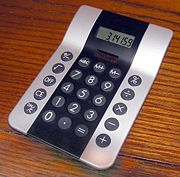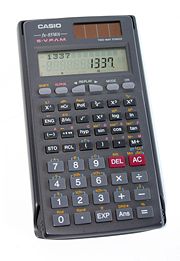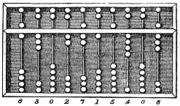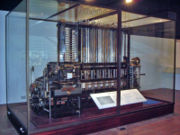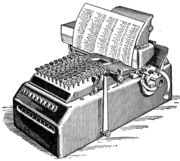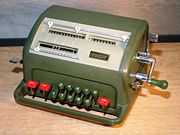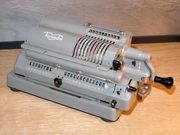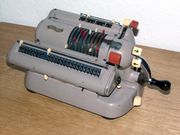Calculator
2008/9 Schools Wikipedia Selection. Related subjects: Mathematics
A calculator is a device for performing mathematical calculations, distinguished from a computer generally by a limited problem domain and an interface optimized for interactive calculation rather than programming. Calculators can be hardware or software, and mechanical or electronic, and are often built into devices such as PDAs or mobile phones.
|
Image:Gosremprom.JPG
An old mechanical calculator.
|
Modern electronic calculators are generally small (often pocket-sized) and usually inexpensive. In addition to general purpose calculators, there are those designed for specific markets; for example, there are scientific calculators which focus on advanced math like trigonometry and statistics. Modern calculators are more portable than most computers, though most PDAs are comparable in size to handheld calculators.
Overview
In the past, mechanical clerical aids such as abaci, comptometers, Napier's bones, books of mathematical tables, slide rules, or mechanical adding machines were used for numeric work. This semi-manual process of calculation was tedious and error-prone.
Modern calculators are electrically powered (usually by battery and/or solar cell) and vary from cheap, give-away, credit-card sized models to sturdy adding machine-like models with built-in printers. They first became popular in the late 1960s as decreasing size and cost of electronics made possible devices for calculations, avoiding the use of scarce and expensive computer resources. By the 1980s, calculator prices had reduced to a point where a basic calculator was affordable to most. By the 1990s they had become common in math classes in schools, with the idea that students could be freed from basic calculations and focus on the concepts.
Computer operating systems as far back as early Unix have included interactive calculator programs such as dc and hoc, and calculator functions are included in almost all PDA-type devices (save a few dedicated address book and dictionary devices).
Electronic calculators
In the past, some calculators were as large as today's computers. The first mechanical calculators were mechanical desktop devices which were replaced by electromechanical desktop calculators, and then by electronic devices using first thermionic valves, then transistors, then hard-wired integrated circuit logic. By the mid-1970s, pocket-sized calculators based on ICs were routinely available, often at prices less than $100, and by the early 1980s the LED displays of 1970s units had been replaced by power-saving liquid crystal displays. Modern electronic calculators range in size from keychain-sized units only a couple of centimeters long all the way up to desktop calculators the size of a textbook, and in complexity from very basic up to graphing calculators capable of video display and sometimes extensive general-purpose programming capability.
Basic configuration
A simple modern calculator (usually known colloquially as a "four function" calculator, even with the presence of a square root button) might consist of the following parts:
- A power source, such as a battery or a solar panel or both
- A display, usually made from LED lights or liquid crystal (LCD), capable of showing a number of digits (typically 8 or 10)
- Electronic circuitry (often a single chip and some other components)
- A keypad containing:
- The ten digits, 0 to 9
- The decimal point
- The equals sign, to prompt for the answer
- The four arithmetic functions (addition, subtraction, multiplication and division)
- A Cancel (or clear) button, to clear the calculation
- On and off buttons
- Other basic functions, such as square root and percentage (%) (desktop models will sometimes add tax functions and significant digit selectors to simplify work with money)
- A single-number memory, which can be recalled where necessary. It might also have a Cancel Entry button, to clear the numbers entered. (Many scientific calculators have multiple variables available.)
Since the late-1980s, calculators have been installed in other small devices, such as mobile phones, pagers or wrist watches.
Scientific and financial calculators
More complex scientific calculators support trigonometric, statistical and other mathematical functions. The most advanced modern calculators can display graphics, and include features of computer algebra systems. They are also programmable; calculator applications include algebraic equation solvers, financial models and even games. Most calculators of this type can print numbers up to ten digits or decimal places in full on the screen. Scientific notation is used to notate numbers up to a limit chosen by the calculator designer, such as 9.999999999*1099. If a larger number or a mathematical expression yielding a larger number than this is entered (a common example comes from typing "100!", read as "100 factorial") then the calculator might simply display "error".
"Error" might also be displayed if a function or an operation is undefined mathematically; for example, division by zero or even roots of negative numbers (most scientific calculators do not allow complex numbers, though a few do have a special function for working with them). Some, but not most, calculators do distinguish between these two types of "error", though when they do, it is not always easy for the user to understand because they are often given as "Error 1" or "Error 2".
Financial calculators are similar in overall design to scientific calculators, but specialize in time value of money calculations and are used in the accounting and real estate professions.
Only a few companies make professional engineering and finance calculators. They include Casio, Sharp, Hewlett-Packard (HP), Victor and Texas Instruments (TI), as well as Chinese manufacturer Karce, who provides OEM calculators for the private label market. Such calculators are examples of embedded systems.
Use in education
In most countries, students use calculators for schoolwork. There was some initial resistance to the idea out of fear that basic arithmetic skills would suffer. There remains disagreement about the importance of the ability to perform calculations by hand or "in the head", with some curricula restricting calculator use until a certain level of proficiency has been obtained, while others concentrate more on teaching estimation techniques and problem-solving. Research suggests that inadequate guidance in the use of calculating tools can restrict the kind of mathematical thinking that students engage in.
There are other concerns - for example, that a pupil could use the calculator in the wrong fashion but believe the answer because that was the result given. Teachers try to combat this by encouraging the student to make an estimate of the result manually and ensuring it roughly agrees with the calculated result. Also, it is possible for a child to type in −1 × −1 and obtain the correct answer '1' without realizing the principle involved. In this sense, the calculator becomes a crutch rather than a learning tool, and it can slow down students in exam conditions as they check even the most trivial result on a calculator.
Other concerns on usage
Errors are not restricted to school pupils. Any user could carelessly rely on the calculator's output without double-checking the magnitude of the result — i.e., where the decimal point is positioned. This problem was all but nonexistent in the era of slide rules and pencil-and-paper calculations, when the task of establishing the magnitudes of results had to be done by the user. In addition, algorithmic flaws and rounding techniques can sometimes lead to minor precision errors.
Some fractions such as 2/3 are awkward to display on a calculator display as they are usually rounded to 0.66666667. Also, some fractions such as 1/7 which is 0.14285714285714 can be difficult to recognize in decimal form; as a result, many scientific calculators are able to work in vulgar fractions and/or mixed numbers.
Calculating vs. computing
The fundamental difference between calculators and computers is that computers can be programmed to perform different tasks while calculators are pre-designed with specific functions built in, for example addition, multiplication, logarithms, etc. While computers may be used to handle numbers, they can also manipulate words, images or sounds and other tasks they have been programmed to handle. However, the distinction between the two is quite blurred; some calculators have built-in programming functions, ranging from simple formula entry to full programming languages such as RPL or TI-BASIC. Graphing calculators in particular can, along with PDAs, be viewed as direct descendants of the 1980s pocket computers, essentially calculators with full keyboards and programming capability.
The market for calculators is extremely price-sensitive, to an even greater extent than the personal computer market; typically the user desires the least expensive model having a specific feature set, but does not care much about speed (since speed is constrained by how fast the user can press the buttons). Thus designers of calculators strive to minimize the number of logic elements on the chip, not the number of clock cycles needed to do a computation.
For instance, instead of a hardware multiplier, a calculator might implement floating point mathematics with code in ROM, and compute trigonometric functions with the CORDIC algorithm because CORDIC does not require hardware floating-point. Bit serial logic designs are more common in calculators whereas bit parallel designs dominate general-purpose computers, because a bit serial design minimizes the chip complexity, but takes many more clock cycles. (Again, the line blurs with high-end calculators, which use processor chips associated with computer and embedded systems design, particularly the Z80, MC68000, and ARM architectures, as well as some custom designs specifically made for the calculator market.)
Personal computers and personal digital assistants can perform general calculations in a variety of ways:
- Most computer operating systems, at least those that support some kind of multitasking, include calculator programs, both text mode (such as the Unix bc (1) language) and graphical mode ( Mac OS Calculator, Microsoft Calculator, KCalc, Grapher). Most, though not all, imitate the interface of a physical calculator. Some shell programs and interpreted programming languages also provide interactive calculation functions.
- For more complex calculations requiring large amounts of organized data, spreadsheet programs such as Excel or OpenOffice Calc provide calculation and sometimes reporting functions.
- Computer algebra programs such as Mathematica, Maple or Matlab can handle advanced calculations.
- Client-side scripting can be used for calculations, e.g. by entering "
javascript:alert(calculation written in JavaScript)" in a web browser's address bar (as opposed to "http://website name"). Such calculations can be embedded in a separate Javascript or HTML file as well. - Online calculators such as the calculator feature of the Google search engine can perform calculations server-side.
History
Origin: the abacus
The first calculators were abaci, and were often constructed as a wooden frame with beads sliding on wires. Abacuses were in use centuries before the adoption of the written Arabic numerals system and are still used by some merchants, fishermen and clerks in China and elsewhere.
The 17th century
William Oughtred invents the slide rule in 1622 and is revealed by his student Richard Delamain in 1630. Wilhelm Schickard built the first automatic calculator called the "Calculating Clock" in 1623. Some 20 years later, in 1643, French philosopher Blaise Pascal invented the calculation device later known as the Pascaline, which was used for taxes in France until 1799. The German philosopher G.W.v. Leibniz also produced a calculating machine.
The 19th century
- In 1822 Charles Babbage proposed a mechanical calculator, called a difference engine, which was capable of holding and manipulating seven numbers of 31 decimal digits each. Babbage produced two designs for the difference engine and a further design for a more advanced mechanical programmable computer called an analytical engine. None of these designs were completely built by Babbage. In 1991 the London Science Museum followed Babbage's plans to build a working difference engine using the technology and materials available in the 19th century.
- In 1853 Per Georg Scheutz completed a working difference engine based on Babbage's design. The machine was the size of a piano, and was demonstrated at the Exposition Universelle in Paris in 1855. It was used to create tables of logarithms.
- In 1872, Frank Baldwin in the U.S.A. invented the pin-wheel calculator, which was also independently invented two years later by W.T. Odhner in Sweden. The Odhner models, and similar designs from other companies, sold many thousands into the 1970s.
- In 1875 Martin Wiberg re-designed the Babbage/Scheutz difference engine and built a version that was the size of a sewing machine.
- Dorr E. Felt, in the U.S.A., invented the Comptometer in 1884, the first successful key-driven adding and calculating machine ["key-driven" refers to the fact that just pressing the keys causes the result to be calculated, no separate lever has to be operated]. In 1886 he joined with Robert Tarrant to form the Felt & Tarrant Manufacturing Company which went on to make thousands of Comptometers.
- In 1891 William S. Burroughs began commercial manufacture of his printing adding calculator. Burroughs Corporation became one of the leading companies in the accounting machine and computer businesses.
- The "Millionaire" calculator was introduced in 1893. It allowed direct multiplication by any digit - "one turn of the crank for each figure in the multiplier".
1900s to 1960s
Mechanical calculators reach their zenith
The first half of the 20th century saw the gradual development of the mechanical calculator mechanism.
The Dalton adding-listing machine introduced in 1902 was the first of its type to use only ten keys, and became the first of many different models of "10-key add-listers" manufactured by many companies.
In 1948 the miniature Curta calculator, that was held in one hand for operation, was introduced after being developed by Curt Herzstark in a Nazi concentration camp. This was an extreme development of the stepped-gear calculating mechanism.
From the early 1900s through the 1960s, mechanical calculators dominated the desktop computing market (see History of computing hardware). Major suppliers in the USA included Friden, Monroe, and SCM/Marchant. (Some comments about European calculators follow below.) These devices were motor-driven, and had movable carriages where results of calculations were displayed by dials. Nearly all keyboards were full — each digit that could be entered had its own column of nine keys, 1..9, plus a column-clear key, permitting entry of several digits at once. (See the illustration of a 1914 mechanical calculator.) One could call this parallel entry, by way of contrast with ten-key serial entry that was commonplace in mechanical adding machines, and is now universal in electronic calculators. (Nearly all Friden calculators had a ten-key auxiliary keyboard for entering the multiplier when doing multiplication.) Full keyboards generally had ten columns, although some lower-cost machines had eight. Most machines made by the three companies mentioned did not print their results, although other companies, such as Olivetti, did make printing calculators.
In these machines, Addition and subtraction were performed in a single operation, as on a conventional adding machine, but multiplication and division were accomplished by repeated mechanical additions and subtractions. Friden made a calculator that also provided square roots, basically by doing division, but with added mechanism that automatically incremented the number in the keyboard in a systematic fashion. Friden and Marchant (Model SKA) made calculators with square root. Handheld mechanical calculators such as the 1948 Curta continued to be used until they were displaced by electronic calculators in the 1970s.
The Facit, Triumphator, and Walther calculators are typical European machines. Similar-looking machines included the Odhner and Brunsviga. Although these are operated by handcranks, there were motor-driven versions. Most machines that look like these use the Odhner mechanism, or variations of it. The Olivetti Divisumma did all four basic operations of arithmetic, and has a printer. Full-keyboard machines, including motor-driven ones, were also used in Europe for many decades. Some European machines had as many as 20 columns in their full keyboards.
The development of electronic calculators
The first main-frame computers, using firstly vacuum tubes and later transistors in the logic circuits, appeared in the late 1940s and 1950s. This technology was to provide a stepping stone to the development of electronic calculators.
In 1954, IBM, in the U.S.A., demonstrated a large all- transistor calculator and, in 1957, the company released the first commercial all-transistor calculator, the IBM 608, though it was housed in several cabinets and cost about $80,000 .
The Casio Computer Co., in Japan, released the Model 14-A calculator in 1957, which was the world's first all-electric "compact" calculator. It did not use electronic logic but was based on relay technology, and was built into a desk.
In October 1961, the world's first all-electronic desktop calculator, the Bell Punch/Sumlock Comptometer ANITA (A New Inspiration To Arithmetic/Accounting) was announced. This British designed-and-built machine used vacuum tubes, cold-cathode tubes and Dekatrons in its circuits, with 12 cold-cathode "Nixie"-type tubes for its display. Two models were displayed, The Mk VII for continental Europe and the Mk VIII for Britain and the rest of the world, both for delivery from early 1962. The Mk VII was a slightly earlier design with a more complicated mode of multiplication and was soon dropped in favour of the simpler Mark VIII version. The ANITA had a full keyboard, similar to mechanical Comptometers of the time, a feature that was unique to it and the later Sharp CS-10A among electronic calculators. Bell Punch had been producing key-driven mechanical calculators of the Comptometer type under the names "Plus" and "Sumlock", and had realised in the mid-1950s that the future of calculators lay in electronics. They employed the young graduate Norbert Kitz, who had worked on the early British Pilot ACE computer project, to lead the development. The ANITA sold well since it was the only electronic desktop calculator available, and was silent and quick.
The tube technology of the ANITA was superseded in June 1963, by the U.S. manufactured Friden EC-130, which had an all-transistor design, 13-digit capacity on a 5-inch CRT, and introduced reverse Polish notation ( RPN) to the calculator market for a price of $2200, which was about triple the cost of an electromechanical calculator of the time. Like Bell Punch, Friden was a manufacturer of mechanical calculators that had decided that the future lay in electronics. In 1964 more all-transistor elctronic calculators were introduced: Sharp introduced the CS-10A, which weighed 25 kg (55 lb) and cost 500,000 yen (~US$2500), and Industria Macchine Elettroniche of Italy introduced the IME 84, to which several extra keyboard and display units could be connected so that several people could make use of it (but apparently not at the same time).
There followed a series of electronic calculator models from these and other manufacturers, including Canon, Mathatronics, Olivetti, SCM (Smith-Corona-Marchant), Sony, Toshiba, and Wang. The early calculators used hundreds of Germanium transistors, since these were then cheaper than Silicon transistors, on multiple circuit boards. Display types used were CRT, cold-cathode Nixie tubes, and filament lamps. Memory technology was usually based on the delay line memory or the magnetic core memory, though the Toshiba "Toscal" BC-1411 appears to use an early form of dynamic RAM built from discrete components. Already there was a desire for smaller and less power-hungry machines.
The Olivetti Programma 101 was introduced in late 1965; it was a stored program machine which could read and write magnetic cards and displayed results on its built-in printer. Memory, implemented by an acoustic delay line, could be partitioned between program steps, constants, and data registers. Programming allowed conditional testing and programs could also be overlaid by reading from magnetic cards. It is regarded as the first personal computer produced by a company (that is, a desktop electronic calculating machine programmable by non-specialists for personal use). The Olivetti Programma 101 won many industrial design awards.
The Monroe Epic programmable calculator came on the market in 1967. A large, printing, desk-top unit, with an attached floor-standing logic tower, it was capable of being programmed to perform many computer-like functions. However, the only branch instruction was an implied unconditional branch (GOTO) at the end of the operation stack, returning the program to its starting instruction. Thus, it was not possible to include any conditional branch (IF-THEN-ELSE) logic. During this era, the absence of the conditional branch was sometimes used to distinguish a programmable calculator from a computer.
The first handheld calculator was developed by Texas Instruments in 1967. It could add, multiply, subtract, and divide, and its output device was a paper tape.
1970s to mid-1980s
The electronic calculators of the mid-1960s were large and heavy desktop machines due to their use of hundreds of transistors on several circuit boards with a large power consumption that required an AC power supply. There were great efforts to put the logic required for a calculator into fewer and fewer integrated circuits (chips) and calculator electronics was one of the leading edges of semiconductor development. U.S. semiconductor manufacturers led the world in Large Scale Integration (LSI) semiconductor development, squeezing more and more functions into individual integrated circuits. This led to alliances between Japanese calculator manufacturers and U.S. semiconductor companies: Canon Inc. with Texas Instruments, Hayakawa Electric (later known as Sharp Corporation) with North-American Rockwell Microelectronics, Busicom with Mostek and Intel, and General Instrument with Sanyo.
Pocket calculators
By 1970 a calculator could be made using just a few chips of low power consumption, allowing portable models powered from rechargeable batteries. The first portable calculators appeared in Japan in 1970, and were soon marketed around the world. These included the Sanyo ICC-0081 "Mini Calculator", the Canon Pocketronic, and the Sharp QT-8B "micro Compet". The Canon Pocketronic was a development of the "Cal-Tech" project which had been started at Texas Instruments in 1965 as a research project to produce a portable calculator. The Pocketronic has no traditional display; numerical output is on thermal paper tape. As a result of the "Cal-Tech" project Texas instruments was granted master patents on portable calculators.
Sharp put in great efforts in size and power reduction and introduced in January 1971 the Sharp EL-8, also marketed as the Facit 1111, which was close to being a pocket calculator. It weighed about one pound, had a vacuum fluorescent display, rechargeable NiCad batteries, and initially sold for $395.
However, the efforts in integrated circuit development culminated in the introduction in early 1971 of the first "calculator on a chip", the MK6010 by Mostek, followed by Texas Instruments later in the year. Although these early hand-held calculators were very expensive, these advances in electronics, together with developments in display technology (such as the vacuum fluorescent display, LED, and LCD), lead within a few years to the cheap pocket calculator available to all.
The first truly pocket-sized electronic calculator was the Busicom LE-120A "HANDY", which was marketed early in 1971. Made in Japan, this was also the first calculator to use an LED display, the first hand-held calculator to use a single integrated circuit (then proclaimed as a "calculator on a chip"), the Mostek MK6010, and the first electronic calculator to run off replaceable batteries. Using four AA-size cells the LE-120A measures 4.9x2.8x0.9 in (124x72x24 mm).
The first American-made pocket-sized calculator, the Bowmar 901B (popularly referred to as The Bowmar Brain), measuring 5.2×3.0×1.5 in (131×77×37 mm), came out in the fall of 1971, with four functions and an eight-digit red LED display, for $240, while in August 1972 the four-function Sinclair Executive became the first slimline pocket calculator measuring 5.4×2.2×0.35 in (138×56×9 mm) and weighing 2.5 oz (70g). It retailed for around $150 (GB£79). By the end of the decade, similar calculators were priced less than $10 (GB£5).
The first Soviet-made pocket-sized calculator, the "Elektronika B3-04" was developed by the end of 1973 and sold at the beginning of 1974.
One of the first low-cost calculators was the Sinclair Cambridge, launched in August 1973. It retailed for £29.95, or some £5 less in kit form. The Sinclair calculators were successful because they were far cheaper than the competition; however, their design was flawed and their accuracy in some functions was questionable. The scientific programmable models were particularly poor in this respect, with the programmability coming at a heavy price in transcendental accuracy.
Meanwhile Hewlett Packard (HP) had been developing its own pocket calculator. Launched in early 1972 it was unlike the other basic four-function pocket calculators then available in that it was the first pocket calculator with scientific functions that could replace a slide rule. The $395 HP-35, along with all later HP engineering calculators, used reverse Polish notation (RPN), also called postfix notation. A calculation like "8 plus 5" is, using RPN, performed by pressing "8", "Enter↑", "5", and "+"; instead of the algebraic infix notation: "8", "+", "5", "=").
The first Soviet scientific pocket-sized calculator the "B3-18" was completed by the end of 1975.
In 1973, Texas Instruments(TI) introduced the SR-10, (SR signifying slide rule) an algebraic entry pocket calculator for $150. It was followed the next year by the SR-50 which added log and trig functions to compete with the HP-35, and in 1977 the mass-marketed TI-30 line which is still produced.
The first programmable pocket calculator was the HP-65, in 1974; it had a capacity of 100 instructions, and could store and retrieve programs with a built-in magnetic card reader. A year later the HP-25C introduced continuous memory, i.e. programs and data were retained in CMOS memory during power-off. In 1979, HP released the first alphanumeric, programmable, expandable calculator, the HP-41C. It could be expanded with RAM (memory) and ROM (software) modules, as well as peripherals like bar code readers, microcassette and floppy disk drives, paper-roll thermal printers, and miscellaneous communication interfaces ( RS-232, HP-IL, HP-IB).
The first Soviet programmable calculator Elektronika " B3-21" was developed by the end of 1977 and sold at the beginning of 1978. The successor of B3-21, the Elektronika B3-34 wasn't backward compatible with B3-21, even if it kept the reverse Polish notation (RPN). Thus B3-34 defined a new command set, which later was used in all programmable soviet calculators. There are hundreds of developed programs for science, business and even games for these machines. The Elektronika MK-52 calculator (using the extended B3-34 command set, and featuring internal EEPROM memory for storing programs and external interface for EEPROM cards and other periphery) was used in soviet spacecraft program (for Soyuz TM-7 flight) as a backup of the board computer.
Mechanical calculators continued to be sold, though in rapidly decreasing numbers, into the early 1970s, with many of the manufacturers closing down or being taken over. Comptometer type calculators were often retained for much longer to be used for adding and listing duties, especially in accounting, since a trained and skilled operator could enter all the digits of a number in one movement of the hands on a Comptometer quicker than was possible serially with a 10-key electronic calculator. The spread of the computer rather than the simple electronic calculator put an end to the Comptometer. Also, by the end of the 1970s, the slide rule had become obsolete.
Technical improvements
Through the 1970s the hand-held electronic calculator underwent rapid development. The red LED and blue/green vacuum-fluorescent displays consumed a lot of power and the calculators either had a short battery life (often measured in hours, so rechargeable Nickel-Cadmium batteries were common) or were large so that they could take larger, higher capacity batteries. In the early 1970s Liquid crystal displays (LCDs) were in their infancy and there was a great deal of concern that they only had a short operating lifetime. Busicom introduced the Busicom LE-120A "HANDY" calculator, the first pocket-sized calculator and the first with an LED display, and announced the Busicom LC with LCD display. However, there were problems with this display and the calculator never went on sale. The first successful calculators with LCDs were manufactured by Rockwell International and sold from 1972 by other companies under such names as: Dataking LC-800, Harden DT/12, Ibico 086, Lloyds 40, Lloyds 100, Prismatic 500 (aka P500), Rapid Data Rapidman 1208LC. The LCDs were an early form with the numbers appearing as silver against a dark background. To present a high-contrast display these models illuminated the LCD using a filament lamp and solid plastic light guide, which negated the low power consumption of the display. These models appear to have been sold only for a year or two.
A more successful series of calculators using the reflective LCD display was launched in 1972 by Sharp Inc with the Sharp EL-805, which was a slim pocket calculator. This, and another few similar models, used Sharp's "COS" (Crystal on Substrate) technology. This used a glass-like circuit board which was also an integral part of the LCD. In operation the user looked through this "circuit board" at the numbers being displayed. The "COS" technology may have been too expensive since it was only used in a few models before Sharp reverted to conventional circuit boards, though all the models with the reflective LCD displays are often referred to as "COS".
In the mid-1970s the first calculators appeared with the now "normal" LCDs with dark numerals against a grey background, though the early ones often had a yellow filter over them to cut out damaging UV rays. The big advantage of the LCD is that it is passive and reflects light, which requires much less power than generating light. This led the way to the first credit-card-sized calculators, such as the Casio Mini Card LC-78 of 1978, which could run for months of normal use on a couple of button cells.
There were also improvements to the electronics inside the calculators. All of the logic functions of a calculator had been squeezed into the first "Calculator on a chip" integrated circuits in 1971, but this was leading edge technology of the time and yields were low and costs were high. Many calculators continued to use two or more integrated circuits (ICs), especially the scientific and the programmable ones, into the late 1970s.
The power consumption of the integrated circuits was also reduced, especially with the introduction of CMOS technology. Appearing in the Sharp "EL-801" in 1972, the transistors in the logic cells of CMOS ICs only used any apreciable power when they changed state. The LED and VFD displays had often required additional driver transistors or ICs, whereas the LCD displays were more amenable to being driven directly by the calculator IC itself.
With this low power consumption came the possibility of using solar cells as the power source, realised around 1978 by such calculators as the Royal Solar 1, Sharp EL-8026, and Teal Photon.
A pocket calculator for everyone
At the beginning of the 1970s hand-held electronic calculators were very expensive, costing two or three weeks' wages, and so were a luxury item. The high price was due to their construction requiring many mechanical and electronic components which were expensive to produce, and production runs were not very large. Many companies saw that there were good profits to be made in the calculator business with the margin on these high prices. However, the cost of calculators fell as components and their production techniques improved, and the effect of economies of scale were felt.
By 1976 the cost of the cheapest 4-function pocket calculator had dropped to a few dollars, about one twentieth of the cost five years earlier. The consequences of this were that the pocket calculator was affordable, and that it was now difficult for the manufacturers to make a profit out of calculators, leading to many companies dropping out of the business or closing down altogether. The companies that survived making calculators tended to be those with high outputs of higher quality calculators, or producing high-specification scientific and programmable calculators.
Mid-1980s to present
The first calculator capable of symbolic computation was the HP-28, released in 1987. It was able to, for example, solve quadratic equations symbolically. The first graphing calculator was the Casio fx7000G released in 1985.
The two leading manufacturers, HP and TI, released increasingly feature-laden calculators during the 1980s and 1990s. At the turn of the millennium, the line between a graphing calculator and a handheld computer was not always clear, as some very advanced calculators such as the TI-89, the Voyage 200 and HP-49G could differentiate and integrate functions, solve differential equations, run word processing and PIM software, and connect by wire or IR to other calculators/computers.
The HP 12c financial calculator is still produced. It was introduced in 1981 and is still being made with few changes. The HP 12c featured the reverse Polish notation mode of data entry. In 2003 several new models were released, including an improved version of the HP 12c, the "HP 12c platinum edition" which added more memory, more built-in functions, and the addition of the algebraic mode of data entry.
Online calculators are programs designed to work just like a normal calculator does. Usually the keyboard (or the mouse clicking a virtual numpad) is used, but other means of input (e.g. slide bars) are possible.
Thanks to the Internet, many new types of calculators are possible for calculations that would otherwise be much more difficult or impossible, such as for real time currency exchange rates, loan rates and statistics.
Patents
- – Complex computer – G. R. Stibitz, Bell Laboratories, 1954 (filed 1941, refiled 1944), electromechanical (relay) device that could calculate complex numbers, record, and print results by teletype
- – Miniature electronic calculator – J. S. Kilby, Texas Instruments, 1974 (originally filed 1967), handheld (3 lb, 1.4 kg) battery operated electronic device with thermal printer
- The Japanese Patent Office granted a patent in June 1978 to Texas Instruments (TI) based on US patent 3819921, notwithstanding objections from 12 Japanese calculator manufacturers. This gave TI the right to claim royalties retroactively to the original publication of the Japanese patent application in August 1974. A TI spokesman said that it would actively seek what was due, either in cash or technology cross-licensing agreements. Nineteen other countries, including the United Kingdom, had already granted a similar patent to Texas Instruments. – New Scientist, 17 Aug. 1978 p455, and Practical Electronics (British publication), October 1978 p1094.
- – Floating Point Calculator With RAM Shift Register - 1977 (originally filed GB Mar 1971, US Jul 1971), very early single chip calculator claim.
- – Extended Numerical Keyboard with Structured Data-Entry Capability – J. H. Redin, 1997 (originally filed 1996), Usage of Verbal Numerals as a way to enter a number.
